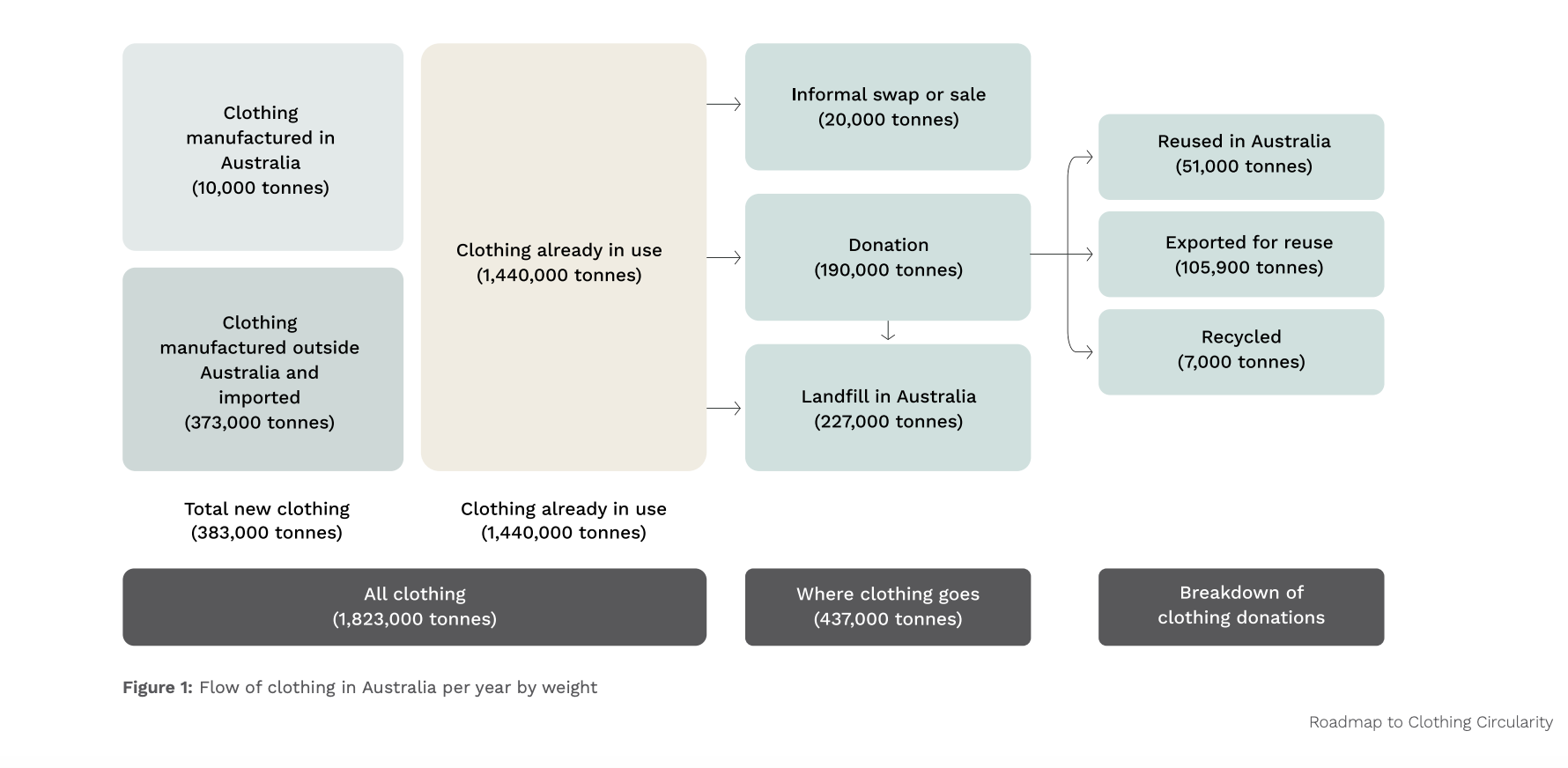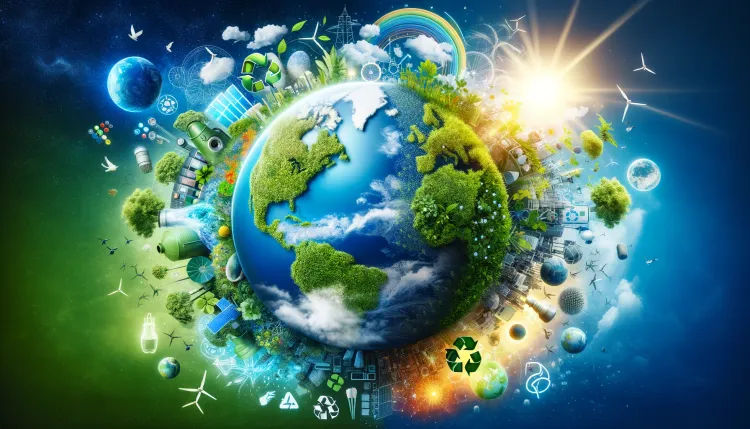Clothes Made From Pollution, Recycled Plastic: Fashion Faux Pas or Fix? Plus Oz Fashion’s Circularity By 2030 Roadmap

Hello everyone.
Welcome to this week's edition of What's Up in Waste. Today, we're going to be focusing on fashion and sustainability, and in particular, the use of recycled materials.
You can read on or listen to the 5 minute version here
Recycled Plastic: Fashion Faux Pas or Fix?
I saw a really interesting news clip the other day on Instagram with CBC News interviewing Linda Greer, who's a leading environmental scientist and a pioneer in sustainable fashion having worked with designers like Stella McCartney to change the processes to make clothes more sustainable.
Now, what was really thought provoking about this clip was that they were talking about how when brands are using recycled material made from plastic bottles and weaving it into something like a t-shirt, how that is not actually a circular model, because eventually that t-shirt at the end of life is very likely to still be hitting our landfill and entering back into a linear chain.

While the plastic bottle being recycled is dealing with that type of waste, it being used in a t-shirt that is then thrown away in a landfill means it is still contributing to the problem of landfills.
So, if using recycled material in clothes isn't a sustainable solution, then what is? Is it more up-cycling? Is it re-evaluating how we're making these clothes? Is it re-evaluating how many of these things that we need in our lives?
You can watch the full CBC News Interview here.
Clothes Made From Pollution
And that leads to our next story, which is about a startup that has invented a way to make clothes out of air! Specifically, CO2 emissions.
Meryl Streep in Devil Wears Prada - 20th Century Fox Movies via GIPHY
Rubi Labs was started by twin sisters, Neeka and Leila Mashouf, who are based in Northern California. Inspired by their love of the environment and with a family background in fashion, the sisters grew up to be scientists who wanted to make a positive impact.

So their technology is really interesting. Their process starts by taking flue gas from manufacturing facilities on one end. It then goes through the Rubi Labs reactor system, which allows for something called ‘enzymatic capture’ of CO2 from the waste stream.
So they're capturing the CO2, and then they're turning this into a material that can be used in existing textile manufacturing processes.
And at the end of life, because of the way that this material is made, it's 100 percent biodegradable, which is fantastic. Definitely, Rubi Labs is one to watch and perhaps has the alternative solution to using recycled fabrics.
Australia's Fashion Industry Aims for Circularity by 2030
Did you know that Australians dispose of 200,000 tonnes of clothing in landfills annually?
To counter this trend, the Australian Fashion Council has launched the Seamless Clothing Stewardship Scheme. This initiative is focused on revolutionising how clothing is produced, consumed, and recycled in Australia to help meet our national net-zero targets. The industry's goal is to achieve Circularity by 2030.
The roadmap outlines that 10,000 tonnes of clothing are produced in Australia annually, with an additional 373,000 tonnes imported. This means that 383,000 tonnes of new clothing items are added each year. Additionally, there are around 1.4 billion tonnes of clothing already in use, including those in the back of cupboards or in thrift shops.

While we are making efforts to sell, swap, or donate clothing to avoid it ending up in landfills, the majority of it still does.
The Australian Fashion Council aims to begin by focusing on the foundation of this issue, looking at circular design, circular business models, and closing the loop. This involves expanding existing clothing collection methods and enabling recycling. We must also change our buying habits and how we manage clothing.
To learn more about this groundbreaking initiative, visit the Australian Fashion Council website.
🗓️ Social Diary
A whirlwind of November events we’re attending:
Tues 28/11 Australian Climate Tech Festival & Awards 2023 at Town Hall, Sydney. Hosted by Climate Salad, An all-day festival of Climate Tech innovation, finishing with an Awards event. Ticketed event. More info on their website.
Weds 29/11 Australian Biochar Industry 2030 Roadmap Rollout - Virtual & F2F Event at Western Sydney Uni, Parramatta. Free event.
The Australia New Zealand Biochar Industry Group (ANZBIG) is presenting the National Biochar Industry 2030 Roadmap at Western Sydney University with NSW Decarbonisation Hub. Free registration on their website here.
📲 Trending on Green Socials
Here's our top three trending hashtags on Insta and FB this week:
- #Repurpose (4.7k likes/post): This hashtag is gaining popularity for its focus on creative and sustainable living. Posts under this hashtag often feature innovative DIY projects, from transforming old furniture into chic home decor to converting discarded materials into useful household items. This trend reflects a growing awareness about the importance of sustainability and the joy of giving new life to old things.
- #UpcycleFashion (10.5k likes/post): Dominating social media, especially among the fashion-conscious and environmentally aware, this hashtag celebrates the art of upcycling in the world of fashion. It showcases how old or discarded clothing can be transformed into trendy, unique, and stylish outfits. This movement not only champions sustainable fashion but also encourages individual creativity and personal style to be both eco-friendly and fashionable.
- #MakeDoAndMend (3.9k likes/post): Rooted in a philosophy of sustainability and resourcefulness, this hashtag is all about repairing and refurbishing rather than discarding. It harkens back to older times when making do with what one had and mending items to extend their life was common.
Book Of The Week
Fashionopolis: The Price of Fast Fashion and the Future of Clothes
by Dana Thomas
Dana Thomas explores the rebirth of sustainable, ethical fashion, showcasing innovators in the field who are paving the way for a more environmentally conscious approach to fashion. It's a great read for anyone interested in understanding the complexities of the fashion industry and the emerging trends in sustainability.
On Amazon here. https://www.amazon.com.au/Fashionopolis-Price-Fashion-Future-Clothes/dp/0735224013
Thanks for reading this far; I appreciate your time! If you've liked this update why not share with three others who may enjoy it too.
Till Next Week, Keep It Greener! 💚🌏
Jane & Team Laying Waste Media
You can get this newsletter sent directly to our inbox, simply subscribe for free here. Or tune into our weekly podcast, 'Whats Up In Waste' available on Apple Podcasts & Spotify.






